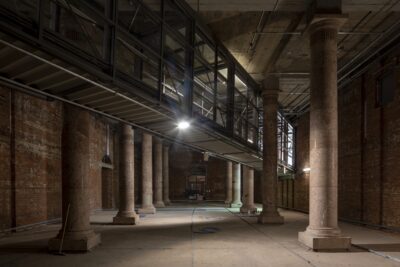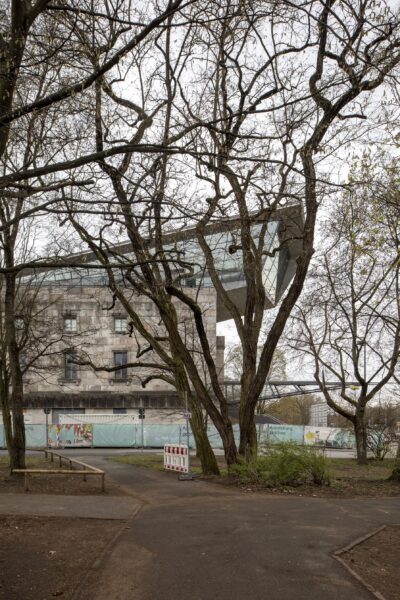Documentation Center, Nazi Party Rally Grounds, Nuremberg, 1998–2001

GÜNTHER DOMENIG AND GERHARD WALLNER
© Photo: Gerhard Maurer, 2022
Following the design for the regional exhibition in Heft/Hüttenberg, Günther Domenig was invited to participate in the competition for the construction of the documentation centre on the site of the former Nazi Party Rally Grounds in Nuremberg.
As the “City of Nazi Party Rallies”, Nuremberg was, according to Albert Speer’s plan, to have been given a parade ground with a congress hall and stadium. Work began on the monumental project in 1935 but construction was halted in 1941 due to the war.
The jury were amazed and convinced by Günther Domenig’s proposal: his design did not envisage an extension to the congress hall planned by Ludwig and Franz Ruff, but instead the piercing and opening of the existing building, implementing the new documentation centre within the old structure.
A “stake” is driven through the north wing of the Congress Hall diagonally to the orthogonal grid. Like a bolt of lightning it splits open the traumatising, oppressive walls, forming a central gangway that leads through the building and emerges at the other end. Visitors walk this glass path, always at a distance yet also with a view onto the historic structure, finally coming to a platform that allows one to take in the huge scale of this propaganda architecture.
The clarity and power of this intervention undoubtedly also lies in the fact that all of the straight lines run in a single direction towards one point. The gesture itself, the cutting, the splitting, the throwing, are the architecture here. Like the Z‑Sparkasse, the Documentation Center is a built movement that has been developed from a single design sketch.
Domenig’s intervention is not just destruction, but also an unearthing through which he allows us to look into the depths (abysses) of built Nazi ideology.
For Domenig, who grew up in a National Socialist family and saw himself as an anti-fascist all his life, the project in Nuremberg was a way of coming to terms with his own history. “So Domenig uncovers the shapeless brick cadaver, outwardly clad in natural stone, for the coroner’s inquest itself.”
Die Zeit, No. 46, 8.11.2001



